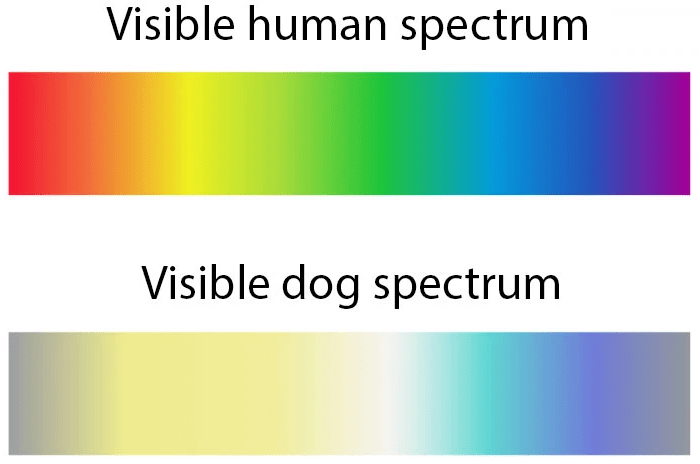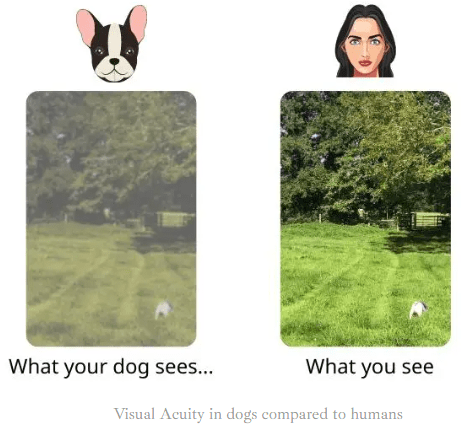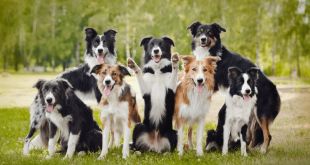Dogs are known to be superhuman sniffers, but what do you know about their vision? You may be surprised to know there are several ways in which our visions are better than that of dogs. First, however, ensure you are not trying to race them in the dark, as you would inevitably come out on the losing end.
If you talk to veterinarians and experts, you will better understand how dogs see the world around them.
How is the vision of a dog different from that of a human?
As we have said already, dogs and people have different visions.
Both have rods and cones, which are light-sensitive cells, at the backs of their eyes. However, human beings have more cones connected to vision sharpness and colors.
Dogs have more rods in their eyes, making them good at catching motion and seeing in dim light. It means humans can see things in finer detail – far away and up close. Experts say that our visions are much better than those of dogs. For example, holding your hand close to a dog would be a bit blurry for them.
It is not as if they can see just as crisply as we can at a distance. Experts say that rather than 20/20 vision, dogs have more of a 20/40 or 20/50 vision. It means that for a dog to see what we can see at 40 or 50 feet, it would have to stand 20 feet away from the object.
However, they are a lot more sensitive when detecting motion. Thus, you can see a rabbit freeze whenever a dog walks past them. It is easier to see a bunny blending in the surroundings than for a dog. However, if the rabbit moves, watch out for them!

Are dogs able to see in the dark?
Dogs are much better at seeing in the dark because they have more rods in their eyes. Most dog breeds also have tapetum lucidum, a shiny layer at the back of their eyes. It functions like a mirror and lets light bounce back and forth against its lens.
It improves the amount of light that their eyes can absorb. So you don’t need to leave in the morning for dogs. They can see just as well as long as they have ambient lighting.
Can dogs be farsighted or nearsighted?
Experts say that some dog breeds tend to be nearsighted or farsighted. The most well-studied and classic example is the Labrador breed. They may inherit the problem of nearsightedness which can affect how well they perform in the field.
However, the only time when you would be able to tell if your dog has slightly worse vision than other pups is when they compete in dog-sport competitions where they need super-sharp vision.
Are dogs able to see color?
The thing with dogs is that the world is less colorful than it is for us. Dogs are dichromatic in that they have just two types of cones in their eyes. Thus, they see everything in a spectrum of yellow and blue. Yes, that applies to you too.
Even grass does not appear to be green to them. But on the other hand, people are trichromatic, meaning they have three kinds of cones. So, unless people are color blind, they can see green and red.

How sharp is the vision of a dog?
Along with missing some hues detected by the human eye, dogs are not as sharp as humans regarding vision. In a study done in 2017, it was seen that dogs have 20/50 vision in well-lit conditions, which implies that they are nearsighted. It means that they have to be 20 feet away from something to see it as clearly as a human being who is 50 feet away from the same.
In the test, dogs were rewarded with treats for correctly identifying images containing horizontal or vertical lines and decreasing the space between them.
Signs that your dog is suffering from vision issues
There are several signs your dog may be suffering from vision issues enumerated below:
- they keep bumping into things
- they avoid everyday activities such as going for a walk
- they hug the wall
- they act clingy, aggressive, or nervous in new settings
The vision of dogs is a way, like humans, in the sense that with increasing age, it gets worse.
Read Also: Dog Eye Infection – Causes, Signs and Treatment
How good are dogs at seeing moving objects?
As we have said, there are more rods in a dog’s retina than in a human. These rods are sensitive to shape, dim light, and movement. As a result, dogs are much better at seeing moving objects than stationary objects. Compared to humans, they have 10 to 20 times enhanced motion sensitivity.
Therefore, dogs can pick up even the slightest changes in your body movement and posture. It is a reason you can train dogs with silent cues using just hand gestures.
Dogs have a wider field of view compared to humans.
Predators such as dogs and humans have their eyes located in the front of their heads so that they can perceive depth. While the eyes of a human are set straight forward and are closer together, the eyes of a dog are at an angle of 20 degrees.
It depends on the breed! It is the reason why dogs have such excellent peripheral vision. However, to compensate for this, nature has compromised their binocular vision. It interferes with their depth perception.

What do dogs see when they watch TV?
During the old days, before flat TVs (televisions) came into being, dogs perceived these machines as big flashing lights. Because even though they always seem to emit light, the older TVs just flickered at a rate that was faster than the human eye could perceive.
It was estimated to be around 60 Hz or 60 cycles per second. However, most dogs can recognize flickering light at 70-80 Hz, so they saw TVs as strobe lighting machines.
Frequently Asked Questions
What does a dog’s vision look like?
Dogs are not great at distinguishing colors as humans, but that does not make them any more deficient than them. On the contrary, they are exceptional hunters at night and have better visual acuity in detecting movement.
How do dogs see the world at night?
The eyes of dogs have more rods than humans. It means that they can see much better at night. They also have a layer of eye tissue named tapetum lucidum that humans do not have.
Do dogs see in 3D?
Dogs have peripheral vision and depth perception. They use these to see the world around them in three dimensions and determine the distance between objects.
Can dogs see TV?
Yes, they absolutely can, and most seem to enjoy it. Television shows have several features that appear to be attractive to dogs. First, it includes visual elements such as motion and the sounds emanating from the same.
How do dogs see human faces?
The brains of dogs react just as much to faces as they do to the back of your heads. However, a new study has discovered that dogs are not hardwired to care about human faces as such.
View this post on Instagram
Conclusion
Apart from what we have said so far, a dog’s eyes are not as good at discriminating brightness as the eyes of a human. If you look at this differently, it would mean distinguishing between various shades of objects. Dogs are twice worse than humans when it comes to differentiating between shades compared to humans.
However, if you start feeling bad for your little one, remember that they have a sense of smell that is so incredible, and it is through the different scents that a dog sees the world around them.

 DogExpress
DogExpress


















 in Chandigarh, India.
in Chandigarh, India. 
